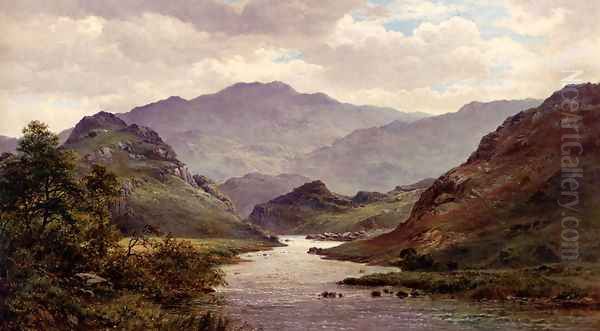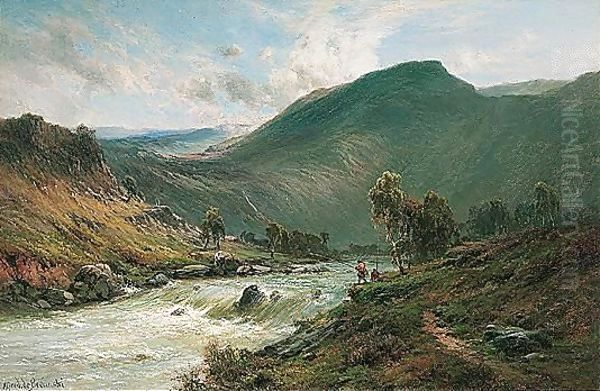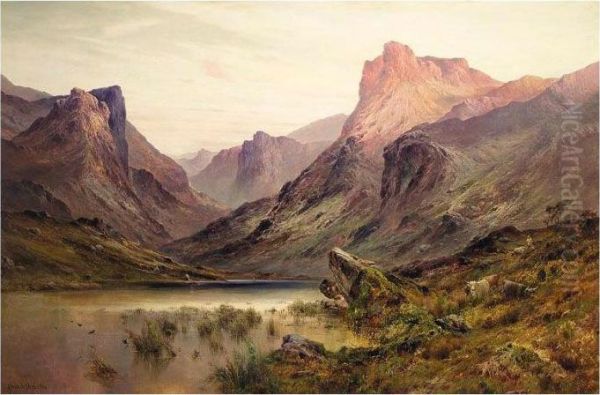
Alfred de Breanski Senior stands as a significant figure in the rich tradition of British landscape painting. Active during the late Victorian and Edwardian periods, from the latter half of the 19th century into the early 20th century, he carved a distinct niche for himself with his evocative and often dramatic depictions of the British Isles' wilder terrains. Born in London in 1852 and passing away there in 1928, his career spanned a time of considerable change in the art world, yet he remained largely dedicated to capturing the sublime beauty of nature, particularly the rugged landscapes of Scotland and Wales, alongside serene views of the River Thames. His work is celebrated for its atmospheric depth, masterful handling of light, and meticulous attention to detail, securing his place as one of the era's most accomplished landscape artists.
Early Life and Artistic Beginnings
Alfred de Breanski was born in Greenwich, London, into a family with Polish immigrant roots. He was the eldest son of Leopold Bréanski, whose profession remains somewhat obscure, but the artistic inclination clearly ran in the family. Alfred's younger brothers, Gustave de Breanski and Jules de Breanski (likely the 'Julie' mentioned in some sources, potentially a mistranscription or anglicization), also pursued careers as painters. This familial connection to the visual arts suggests an environment where creative pursuits were likely encouraged, providing a foundation for Alfred's future path.

His formal artistic training is often cited as having taken place at the Royal Academy Schools in London, a prestigious institution that nurtured many of Britain's finest artists. However, some sources suggest his training might have been less formal or supplemented elsewhere, possibly including time at the St. Martin's School of Art. Regardless of the precise institutional path, he developed a strong technical grounding. His public debut came relatively early; in 1872, at the age of just twenty, he exhibited his first painting at the Royal Academy of Arts. This work, titled 'Evening: Softly falling the even light' (or sometimes cited as 'Soft Light Falls'), was notably purchased by the Bishop of Peterborough, marking an auspicious start to his professional career and signaling the appeal his landscape vision already possessed.
Influences and Development of Style
Like many landscape painters of his generation, de Breanski worked in the shadow of giants. The profound influence of earlier British masters, particularly John Constable (1776-1837) and J.M.W. Turner (1775-1851), is evident in his approach. From Constable, he seems to have absorbed a deep appreciation for the specific character of the British countryside and the importance of capturing atmospheric conditions with fidelity – the play of light across clouds, the texture of foliage, the dampness in the air. Constable's dedication to painting en plein air, directly from nature, likely also informed de Breanski's practice, encouraging close observation.
From Turner, de Breanski inherited a sense of the sublime and the dramatic potential of landscape. Turner's revolutionary use of colour and light to convey emotion and atmosphere, particularly in his depictions of mountains, storms, and luminous sunsets, resonates in de Breanski's more theatrical Highland scenes. While de Breanski's work generally maintains a greater degree of topographical realism than Turner's later, more abstract pieces, the older master's influence can be seen in the younger artist's bold handling of light and his ability to imbue a scene with powerful mood. He skillfully blended these influences, creating a style that balanced Romantic sensibility with detailed, almost photographic, observation.
The Highlands and Wales: A Defining Passion
While he painted various locations, including the familiar landscapes of the River Thames, Alfred de Breanski Sr. became most renowned for his depictions of the Scottish Highlands and the mountains of North Wales, particularly Snowdonia. These regions offered the dramatic vistas and untamed wilderness that perfectly suited his artistic temperament. He travelled extensively through these areas, sketching and gathering material that would later be worked up into large-scale oil paintings in his studio.

His Scottish scenes often feature iconic lochs like Lomond, Katrine, or Tay, framed by towering, mist-shrouded mountains such as Ben Nevis or those found in Glencoe. He had a remarkable ability to capture the unique quality of light in these northern latitudes – the soft, diffused light of a cloudy day, the dramatic shafts of sunlight breaking through after a storm, or the warm, golden glow of sunrise or sunset bathing the peaks in colour. Water, whether the still surface of a loch reflecting the sky or a rushing mountain stream, was rendered with convincing fluidity and transparency.
Similarly, his Welsh paintings capture the rugged grandeur of Snowdonia's peaks and valleys. Works depicting the Colwyn River or the dramatic passes showcase his skill in rendering complex rock formations, the textures of heather and bracken covering the slopes, and the ever-changing Welsh weather. He often included small figures – perhaps a lone shepherd, a traveller, or Highland cattle or sheep grazing – within these vast landscapes. These elements serve not only to add a touch of life and narrative interest but also crucially to emphasize the immense scale and power of the natural world, a common theme in Romantic landscape painting.
Technique and Artistic Vision
De Breanski's technique was characterized by a combination of careful drawing and confident paint handling. His compositions are typically well-structured, often employing traditional landscape conventions like a detailed foreground leading the eye towards a dramatic middle ground and distant vista. He paid meticulous attention to the specific textures of the natural world – the rough surfaces of rocks, the dampness of soil after rain, the intricate patterns of bark and leaves. This detailed realism grounds his work, providing a convincing sense of place.
However, it is his treatment of light and atmosphere that truly elevates his paintings. He was a master of capturing transient effects – the golden hour light, the ethereal quality of mist clinging to mountainsides, the dramatic interplay of sun and shadow. His palette could range from subtle, earthy tones for more tranquil scenes to vibrant hues of orange, pink, and gold for dramatic sunsets over Highland lochs. While fundamentally a realist, his work often shows an awareness of contemporary developments, including touches that hint at the influence of Impressionism, particularly in his looser brushwork in skies or water reflections and his heightened sensitivity to colour and light effects. Yet, he never fully embraced the Impressionist aesthetic, retaining a commitment to detailed representation and structured composition. His art is imbued with a sense of emotion, a palpable love for the landscapes he depicted, but it avoids overt sentimentality, achieving a powerful yet restrained romanticism.
Notable Works

While de Breanski was prolific, several paintings stand out as representative of his style and subject matter:
'The Colwyn River, North Wales': This work exemplifies his Welsh landscapes. It typically presents a panoramic view, showcasing his ability to handle complex compositions with receding planes. The detailed rendering of foreground rocks and vegetation, the shimmering surface of the river, and the atmospheric treatment of the distant mountains under a dynamic sky are characteristic. It reflects the influence of Constable in its attention to specific natural details and meteorological accuracy.
'Evening - Skiddaw & Bassenthwaite - Lake District': Although more famous for Scotland and Wales, de Breanski also painted the English Lake District. This title suggests a focus on the evocative light of dusk. Such works often feature dramatic colour palettes, capturing the fleeting moments as day turns to night. Descriptions mentioning "abstract" or "flying" brushwork might refer to a looser handling, perhaps in the sky or reflections, demonstrating his technical versatility in conveying mood.
'The River Dee' (possibly related to 'The Deans' River' mentioned in sources): Paintings of the River Dee, which flows through both Wales and England, allowed de Breanski to explore different types of river scenery, from its wilder upper reaches to its broader stretches. These works often combine his skill in depicting water with his love for mountainous or pastoral backdrops, blending realism with a romantic atmosphere.
Thames River Scenes: Contrasting with his wilder subjects, de Breanski also produced numerous views along the River Thames. These paintings often depict calmer waters, perhaps near Henley or other picturesque spots, sometimes including river craft or figures enjoying the riverside. They showcase a softer aspect of his art, focusing on gentle light and reflections, though still rendered with his characteristic attention to detail and atmosphere.
The de Breanski Artistic Family
Alfred de Breanski Sr. was not the only artist in his immediate family. In 1873, he married Annie Roberts, a talented Welsh painter in her own right. While less famous than her husband, she exhibited her work and likely shared his passion for landscape. Together, they had seven children. The artistic gene was passed down, most notably to two of their sons: Alfred Fontville de Breanski Jr. (1877-1957) and Arthur de Breanski (fl. 1905-1920).

Alfred Jr., often signing his work 'A. F. de Breanski Jr.', followed closely in his father's footsteps, painting similar subjects – Scottish and Welsh landscapes, often featuring Highland cattle – in a comparable style. This has inevitably led to confusion between the works of father and son, particularly as Jr.'s style matured. While experts can often distinguish between them (Jr.'s work is sometimes considered slightly looser or brighter), careful attention to signatures and provenance is crucial. Arthur also became a painter, though less information is readily available about his career. The presence of multiple artists within the family, including Alfred Sr.'s brothers Gustave and Jules, marks the de Breanskis as a notable artistic dynasty of the period.
Context: The Late Victorian and Edwardian Art World
Alfred de Breanski Sr. worked during a vibrant and diverse period in British art. The Royal Academy, where he frequently exhibited, remained a dominant institution, showcasing a wide range of styles and subjects. He exhibited alongside acclaimed figures of the establishment, such as the President of the Royal Academy, Frederic Leighton (1830-1896), known for his classical subjects, and Lawrence Alma-Tadema (1836-1912), famous for his meticulously detailed scenes of Roman life. The legacy of the Pre-Raphaelites, like John Everett Millais (1829-1896), who later turned to landscape himself, was still felt.
Within landscape painting itself, de Breanski was a contemporary of artists like Benjamin Williams Leader (1831-1923), who painted similarly popular, large-scale, and detailed views of the British countryside, particularly Worcestershire and Wales. Another contemporary, though with a very different mood, was John Atkinson Grimshaw (1836-1893), known for his atmospheric nocturnal and twilight scenes, often of urban docks or moonlit lanes. The detailed, often sentimental, rural scenes of Myles Birket Foster (1825-1899) also enjoyed immense popularity.
While de Breanski's style remained rooted in the Romantic-Realist tradition, newer artistic currents were emerging. The influence of French Impressionism, championed in Britain by artists like James McNeill Whistler (1834-1903) with his emphasis on 'art for art's sake' and tonal harmonies, was beginning to be felt. Later in de Breanski's career, artists like Walter Sickert (1860-1942), associated with the Camden Town Group, were exploring grittier urban subjects and post-impressionist techniques. Although de Breanski did not align himself with these more avant-garde movements, his work demonstrates an awareness of changing approaches to light and colour. He also exhibited in venues that showed international artists, potentially encountering works by figures like the French painter Henri Fantin-Latour (1836-1904) or sculptor Auguste Rodin (1840-1917), reflecting the increasingly cosmopolitan nature of the London art scene.
Later Career, Legacy, and Reputation
Alfred de Breanski Sr. continued to paint and exhibit prolifically into the early 20th century. He maintained his focus on the landscapes that had brought him success, refining his techniques and producing works that were consistently sought after by collectors. He spent his later years residing in the eastern suburbs of London and passed away in the city in 1928 at the age of 76.
His reputation has followed a trajectory common to many successful artists of his era. Hugely popular during his lifetime and in the decades immediately following his death, his work, along with that of many other traditional Victorian and Edwardian landscape painters, fell somewhat out of critical favour during the mid-20th century, overshadowed by the rise of Modernism. His detailed realism and romantic sensibility were sometimes dismissed as old-fashioned or overly picturesque compared to the more challenging art movements that followed.
However, in recent decades, there has been a significant reassessment of Victorian and Edwardian art. De Breanski's paintings have experienced a resurgence in popularity, particularly in the auction market, where his major works command substantial prices. Collectors and curators now appreciate his exceptional technical skill, his profound connection to the British landscape, and his masterful ability to capture light and atmosphere. His work is recognized for its enduring appeal and its specific contribution to the landscape tradition. His paintings are held in numerous public collections in the UK, including the Southampton City Art Gallery, the Laing Art Gallery in Newcastle upon Tyne, and Brighton & Hove Museums, ensuring his legacy endures. He is now seen not merely as a competent academic painter, but as a distinctive voice who captured the majesty and specific character of Britain's wild places with passion and precision.
Conclusion: Master of Light and Landscape
Alfred de Breanski Sr. remains a compelling figure in British art history. He dedicated his long career to the celebration of the natural beauty of Scotland, Wales, and England, translating the grandeur of mountains, the serenity of lochs, and the gentle flow of rivers onto canvas with remarkable skill. His ability to blend detailed realism with a deeply felt romanticism, all illuminated by a masterful handling of light and atmosphere, defines his unique contribution.
Influenced by the great landscape traditions of Constable and Turner, yet developing his own distinct style that subtly incorporated contemporary awareness of colour and light, de Breanski created a body of work that resonated deeply with the public of his time and continues to find admirers today. While navigating an art world undergoing significant change, he remained true to his vision, capturing the specific moods and textures of the British landscape. As the head of an artistic family and a consistent exhibitor at major institutions, he was a notable presence in the art scene. Today, his paintings stand as powerful testaments to the enduring allure of the natural world and the ability of a skilled artist to convey its majesty and poetry. Alfred de Breanski Sr. rightfully holds his place as a master interpreter of Britain's most dramatic and cherished landscapes.